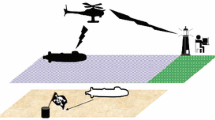Abstract
Deep reasoning diagnostic procedures are model-based, inferring single or multiple faults from the knowledge of faulty behavior of component models and their causal structure. The overall goal of this paper is to develop a hierarchical diagnostic system that exploit knowledge of structure and behavior. To do this, we use a hierarchical architecture including local and global diagnosers. Such a diagnostic system for high autonomy systems has been implemented and tested on several examples in the domain of robot-managed fluid-handling laboratory.
Similar content being viewed by others
References
Chi, S.D., Modelling and simulation for high autonomy systems, PhD Dissertation, University of Arizona, 1991.
Chi, S.D. and Zeigler, B.P., DEVS-based intelligent control of space adapted fluid mixing,Proc. 5th Conf. on Artificial Intelligence for Space Applications, May 1990.
Chi, S.D., Zeigler, B.P., and Cellier, F.E., Model-based task planning system for a space laboratory environment,SPIE Conference on Cooperative Intelligent Robotics in Space, Boston, Nov. 1990.
DeKleer, Y. and Williams, B.C., Diagnosing multiple faults,Artificial Intelligence 32 (1987), 97–130.
DeVries, R.C., An automated methodology for generating a fault tree,IEEE Trans. Reliability 39(1) (April 1990).
Garzia, R.F., Garzia, M.R., and Zeigler, B.P., Discrete event simulation,IEEE Spectrum (Dec. 1986), pp. 32–36.
Greiner, R., Smith, B.A., and Wilkerson, R.W., A correction to the algorithm in Reiter's theory of diagnosis,Artificial Intelligence 41 (1989), 79–88.
Ho, Y. Editors introduction, Special Issue on Dynamics of Discrete Event Systems,Proc. IEEE 77(1) (1989).
Klir, G.,Architecture of Systems Problem Solving, Plenum Press, New York, 1985.
Kuipers, B.J., Qualitative reasoning with causal models in diagnosis of complex systems, in L.A. Widman, K.A. Loparo, and N. Nielsen (eds)Artificial Intelligence, Simulation and Modelling, Wiley, New York, 1989, pp. 257–274.
Mesarovic, M.D. and Takahara, Y.,General Systems Theory: Mathematical Foundations, Academic Press, New York, 1975.
Orden, A., On the solution of linear equation/inequality systems,Math. Program. 1 (1971), 137–152.
Patterson-Hine, F.A. and Koen, B.V., Direct evaluation of fault trees using object-oriented programming techniques,IEEE Trans. Reliability 38(2) (June 1989).
Reiter, R., Theory of diagnosis from first principles,Artificial Intelligence 32 (1987), 57–95.
Wang, Q. and Cellier, F.E., Time windows: An approach to automated abstraction of continuoustime models into discrete-event models,Proc. AI, Simulation, and Planning in High Autonomy Systems, Tucson, 1990.
Wymore, A.W.,A Mathematical Theory of Systems Engineering: The Elements, Wiley, New York, 1967.
Zeigler, B.P., DEVS representation of dynamical systems: Event-based intelligent control,IEEE Proc. 77(1) (Jan. 1989), 72–80.
Zeigler, B.P.,Multifaceted Modelling and Discrete Event Simulation, Academic Press, New York, 1984.
Zeigler, B.P.,Object-Oriented Simulation with Hierarchical, Modular Models: Intelligent Agents and Endomorphic Systems, Academic Press, New York, 1990.
Zeigler, B.P., High autonomy systems: Concepts and models,Proc. AI, Simulation and Planning in High Autonomy Systems, Tucson, March 1990.
Zeigler, B.P., Systems formulation of a theory of diagnosis from first principles,IEEE Trans. Reliability 41(1) (1992), 38–48.
Zeigler, B.P. and Chi, S.D., Symbolic discrete event system specification,IEEE Trans. Systems, Man, Cybernet. 22(6) (July 1992), 28–43.
Zeigler, B.P., Cellier, F.E., and Rozenblit, J.W., Design of a simulation environment for laboratory management by robot organizations,J. Intelligent and Robotic Systems 1 (1988), 299–309.
Author information
Authors and Affiliations
Additional information
Research supported by NASA-Ames Co-operative Agreement No. NCC 2-525, ‘A Simulation Environment for Laboratory Management by Robot Organization’.
Rights and permissions
About this article
Cite this article
Chi, SD., Zeigler, B.P. Hierarchical model-based diagnosis for high autonomy systems. J Intell Robot Syst 9, 193–207 (1994). https://doi.org/10.1007/BF01276498
Received:
Issue Date:
DOI: https://doi.org/10.1007/BF01276498




